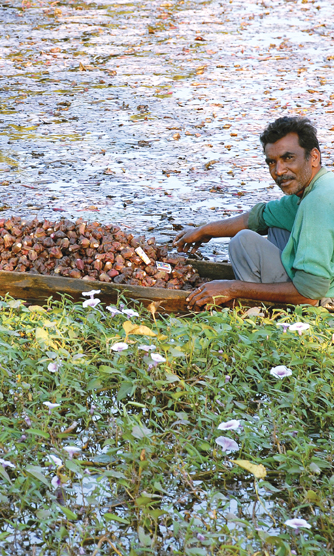Raw Materials Next Topic Labour Practices & Decent
Work and Human Rights
-
Management Approach
Given the essential eco-system services that nature provides, especially to rural households, ITC recognises that the preservation and nurture of biodiversity is crucial for the long-term sustainability of farming communities. In agro-ecosystems, biodiversity provides varied ecosystem services including recycling of nutrients, control of local micro-climate, regulation of local hydrological processes, regulation of the abundance of undesirable organisms and detoxification of noxious chemicals. Decoupling of agro ecosystems from ecosystem services rendered by biodiversity may result in overdependence on external inputs and ever-increasing economic and environmental costs, as well as impacting nutrition and health of consumers at various trophic levels.
The long-term sustainability of ITC's agri-businesses depends on natural capital, which includes land, underground and surface water, and biodiversity. A 'sustainable agriculture area' incorporates ecological and biodiversity concerns and supports livelihood improvements. ITC has, accordingly, taken up biodiversity conservation as a major intervention in its operational areas through various initiatives. This will not only preserve the nation's rich biodiversity, but also ensure a sustainable future for communities residing in the Company's catchment areas.
-
Biodiversity Conservation - Progress
ITC has successfully implemented the programme to establish biodiversity conservation plots in the process of Natural Resources Management to enhance floral and faunal biodiversity as well as ensure adequate livelihood and employment generation to local communities. The objective of the programme has been to motivate the communities to make productive use of degraded common lands through biodiversity conservation. Till now, under this programme, ITC has developed 139 biodiversity plots involving famers and community members covering a total area of 3,942 hectares in 14 districts. The initiative has also helped in conserving thousands species of floral and faunal diversity, including birds, butterflies, reptiles and amphibians. Regular biodiversity indexing is also being carried out in biodiversity conservation plots, to measure the extent of success of the programme in terms of enhancing the species diversity and dominance.
-
Biodiversity Conservation in Agriculture
The Biodiversity Risk and Opportunity Assessment (BROA), is being implemented by our Agri Business Division across our crop growing regions covering Karnataka (Mysore district) and Andhra Pradesh (West Godavari, Prakasam and Guntur district). Over the past two years it has helped the business in building strategy and action plans to embed biodiversity conservation in agriculture practices. The BROA tool provides a method to identify impacts and dependencies of business operations on biodiversity of a given agricultural landscapes, followed by an assessment of the various risks and opportunities that emerge, based on which plans are made and actions undertaken to address them.
The Division's aim on biodiversity management is on embedding biodiversity conservation across its business value chain and helping the farmers to adopt best agricultural practices for sustainable agriculture. For us the focus is not just on species conservation for addressing biodiversity concerns, but the identification of any potential negative impact on ecosystem services and mitigate them in agriculture. Following from this, the following key initiatives were implemented by the Division in 2015 towards biodiversity conservation in agriculture practices.
- Soil Conservation: The business provides inputs to farmers on sustainable agriculture techniques that addresses physical, chemical and biological health of the soil in order to protect valuable soil resources. In 2015 around 7,000 hectares was covered under soil conservation programme covering the states of Andhra Pradesh, Karnataka, Telangana and Rajasthan.
- Water Conservation: Drip irrigation was implemented in 700 hectares of land in Andhra Pradesh covering tobacco and chilli crop saving almost 900 million litres of water.
- Toxic Waste Management to Protect Ecosystem: Farmers were educated on safe disposal of empty pesticide containers by setting up toxic waste collection centres in villages. In 2015 the Company had established around 70 toxic waste collection centres in 70 villages (Andhra Pradesh and Karnataka) by involving local community, village panchayat and farmers. The toxic wastes collected in the centres are scientifically disposed and safely incinerated at the state pollution approved facilities.
-
Mainstreaming Biodiversity Conservation at Landscape Level
Apart from biodiversity conservation in selected plots, ITC has embarked on a watershed level biodiversity conservation aimed at improving biodiversity in a larger area. Assessment of current status and plans for improvement was completed in Ravandoor tank cascade of Mysore district which is spread over 2,300 hectares area. This assessment was done by Kalpataruvu, a non-profit organisation with technical support from University of Agriculture and Horticulture Shivmogga, Karnataka. Based on the study recommendations, a biodiversity conservation action plan was initiated and work was completed in 130 hectares area. This work included activities such as large scale awareness generation and community participation, protection and conservation of existing old trees in the area, plantation of native species on farm-field bunds and in-situ conservation of commons. Similar studies have been initiated in Nanjanayakanahalli and Kothegala cascades in the same district spread over across 4,000 hectares area.
Going forward, ITC will partner with International Union of Conservation of Nature (IUCN) in Munger district of Bihar aimed at restoration of eco-system services for the benefit of agriculture through biodiversity conservation. As part of the collaboration, IUCN will develop an Agriscape Tool, which will enable understanding of the status of natural landscape around farms and ecosystem services being provided. This will enable the program to design suitable interventions to promote crop productivity, simultaneously maintaining farm productivity, soil fertility as well as various other ecosystem services1. The analysis undertaken will help in identifying the missing links/ gaps in important ecosystem services identified for agriculture and allied livelihoods.
1In agro-ecosystems, biodiversity performs varied ecosystem services including recycling of nutrients, control of local microclimate, regulation of local hydrological processes, regulation of the abundance of undesirable organisms, and detoxification of noxious chemicals.
